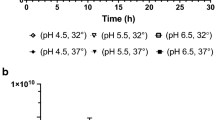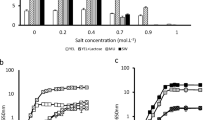Abstract
The temperature-limited fed-batch (TLFB) process is a technique where the oxygen consumption rate is controlled by a gradually declining temperature profile rather than a growth-limiting glucose-feeding profile. In Escherichia coli cultures, it has been proven to prevent an extensive release of endotoxins, i.e. lipopolysaccharides, that occurs in the glucose-limited fed-batch (GLFB) processes at specific growth rates below 0.1 h−1. The TLFB and the GLFB process were compared to each other when applied to produce the periplasmic, constitutively expressed, enzyme β-lactamase. The extraction of the enzyme was performed by osmotic shock. A higher production of β-lactamase was achieved with the TLFB technique while no difference in the endotoxin release was found during the extraction procedure. Furthermore, it was found that growth at declining temperature, generated by the TLFB technique, gradually stabilizes the cytoplasmic membrane, resulting in a significantly increased product quality in the extract from the TLFB cultures in the osmotic shock treatment.







Similar content being viewed by others
References
Baldassare JJ, Rhinehart KB, Silbert DF (1976) Modification of membrane lipid: physical properties in relation to fatty acid structure. Biochemistry 15:2986–2994
Bradford MM (1976) A rapid and sensitive method for the quantitation of microgram quantities of protein utilizing the principle of protein-dye binding. Anal Biochem 72:248–254
Bucklin SE, Fujihara Y, Leeson MC, Morrison DC (1994) Differential antibiotic-induced release of endotoxin from gram-negative bacteria. Eur J Clin Microbiol Infect Disease 13:43–51
Casadei MA, Manas P, Niven G, Needs E, Mackey BM (2002) Role of membrane fluidity in pressure resistance of Escherichia coli NCTC 8164. Appl Environ Microbiol 68:5965–5972
Castan A, Näsman A, Enfors S-O (2002) Oxygen enriched air supply in Escherichia coli processes: production of biomass and recombinant growth hormone. Enzyme Microbiol Technol 30:847–854
Chaib F, Bernier A, Braendli E (1995) Towards large scale methods for the selective release of periplasmic human cystatin C from Escherichia coli. Biotechnol Tech 9:179–184
Cronan JE, Rock CO (1996) Biosynthesis of membrane lipids. In: Neidhart FC (eds) Escherichia coli and Salmonella cellular and molecular biology. American Society for Microbiology, Washington, D.C. pp 612–636
Cronan JE, Gelmann EP (1973) An estimate of the minimum amount of unsaturated fatty acid required for growth of Escherichia coli. J Biol Chem 248:1188–1195
Georgiou G, Shuler ML and Wilson DB (1988) Release of periplasmic enzymes and other physiological effects of β-lactamase overproduction in Escherichia coli. Biotechnol Bioeng 32:741–748
Han L, Enfors S-O, Häggström L (2003) Escherichia coli high-cell-density culture: carbon mass balances and release of outer membrane components. Bioproc Biosyst Eng 25:205–212
Holme T, Arvidsson S, Lindholm B, Pavlu B (1970) Enzymes: laboratory-scale production. Process Biochem 5:62–66
Jahic M, Wållberg F, Bollok M, Garcia P, Enfors S-O (2003) Temperature-limited fed-batch technique for control of proteolysis in Pichia pastoris bioreactor cultures. Microbial Cell Factories URL: http://www.microbialcellfactories.com/content/2/1/6
Moe D, Garbarsch C, Kirkeby S (1994) The protein effect on determination of DNA with Hoechst 33258. J Biochem Biophys Methods 28:263–276
Pelltier C, Bourlioux P, van Heijenoort J (1994) Effects of sub-minimal inhibitory concentrations of EDTA on growth of Escherichia coli and the release of lipopolysaccharide. FEMS Microbiol Lett 117:203–206
Silfversparre G, Enfors S-O, Han L, Häggström L, Skogman H (2002) Method for growth of microorganisms minimising the release of endotoxins from the bacteria to the surrounding medium. PCT/SE01/02370. International publication no. WO02/36746A1
Sinensky M (1974) Homoeviscous adaptation. a homeostatic process that regulates the viscosity of membrane lipids in Escherichia coli. Proc Natl Acad Sci USA 71:522–525
Smith M, Neidhart F (1983) Proteins induced by anaerobiosis in Escherichia coli. J Bacteriol 154:336–343
Sullivan KH, Hegeman GD, Cordes EH (1979) Alteration of the fatty acid composition of Escherichia coli by growth in the presence of normal alcohols. J Bacteriol 138:133–138
Svensson M, Han L, Silfversparre G, Häggström L, Enfors S-O (2004) Control of endotoxin release in Escherichia coli fed-batch cultures. Bioproc Biosyst Eng (in press)
Acknowledgement
This work was supported by a grant from the Swedish Centre for Bioprocess Technology.
Author information
Authors and Affiliations
Corresponding author
Rights and permissions
About this article
Cite this article
Svensson, M., Svensson, I. & Enfors, SO. Osmotic stability of the cell membrane of Escherichia coli from a temperature-limited fed-batch process. Appl Microbiol Biotechnol 67, 345–350 (2005). https://doi.org/10.1007/s00253-004-1832-y
Received:
Revised:
Accepted:
Published:
Issue Date:
DOI: https://doi.org/10.1007/s00253-004-1832-y




